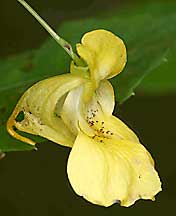
The first sighting of Impatiens pallida for Newton County has been made. Dr. Stephen L. Timme, admittedly while not really looking for it, discovered it on June 26, 2006, along the wooded trail on the south side of Shoal Creek at the Wildcat Park Glade. Timme is a senior professor of botany and director and curator of the Sperry Herbarium at Pittsburg State University, Pittsburg, KS.
While he happened to be in the Wildcat Glade, he said he noticed some of the orange flowered species, otherwise known as spotted touch-me-not or Impatiens capensis, and thought that the yellow flowered species, (pale or yellow touch-me-not, Jewel weed, or Impatiens pallida), might be growing alongside. So, he took a closer look. And he was right. He found several plants with yellow flowers.
Timme explained that there are only two genera in the family Balsaminaceae (Touch-Me-Not family), with some 450 species mostly concentrated in tropical Africa and Asia rather than in the temperate areas (where there are seasons) of Missouri. The species are watery-stemmed annuals that grow to two meters tall. The plant, Timme said, can be identified by looking at one of the sepals of the flower which is modified into a spur (the curved portion).
Distribution of the seeds is quite interesting, he said. The species produces a fruit that has an explosive capsule with the seeds attached to the inner surface of the fruit on valves. When touched, at maturity, the valves suddenly spit apart and each valve spirally coils very rapidly. This results in the seeds suddenly being flung away from the parent plant. Thus, the name touch-me-not is very relevant, Timme said, and the name Jewel Weed as well, since its leaves when placed under water show a shiny, silvery-like surface like jewels.
"I don't know a lot about the plant other than Impatiens comes in cultivated forms for the flower garden," Timme said. What Timme does know about it is its suggested medicinal use. "If one is “stung” by stinging nettle, rubbing the leaves and stems on the infected area will sooth the pain," he said. "It is also reputed to prevent poison ivy rash/blisters when rubbed on the skin immediately following exposure, but apparently both work on some people and not on others."
Impatiens pallida previously had been collected from Jasper and McDonald counties, Timme said, but he personally hadn't seen it in 20 years. He was pleased to find the species growing in a site surrounding the proposed Wildcat Glades Conservation & Audubon Center.






Comments